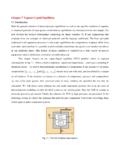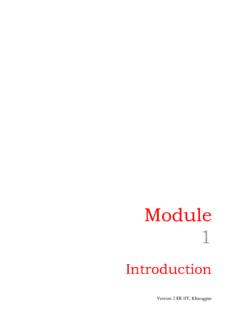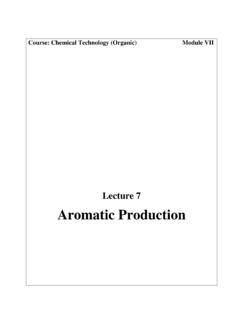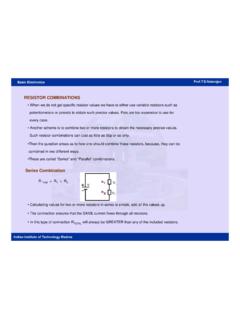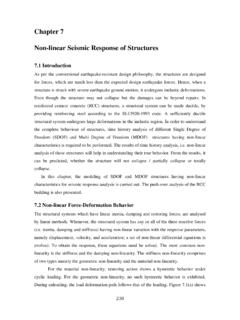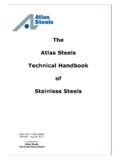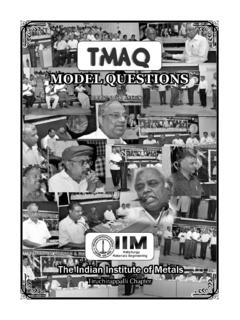Transcription of Properties and Applications of Materials - NPTEL
1 Properties and Applications of Materials Classification of MaterialsMetalsCeramicsMaterialsPolymers MetalsMetalsFerrousNon-FerrousSteel and Cast IronsAl, Cu, Mg MaterialsFerrousSteelsLow AlloyHigh AlloyStainless steelTool steelCast ironFerrous Materials - Steels Steels -alloys of iron-carbon. May contain other alloying elements. Several grades are available. Low Alloy (<10 wt%) Low Carbon (< wt% C) Medium Carbon ( to wt%) High Carbon ( to wt%) High Alloy Stainless steel (> 11 wt% Cr) Tool SteelSteelsLow alloyLowCarbonMediumCarbonHighCarbonHigh alloyStainlessToolLow Carbon steel Plaincarbon steels - very low content of alloying elements and small amounts of Mn. Most abundant grade of steel is low carbon steel - greatest quantity produced; least expensive. Not responsive to heat treatment; cold working needed to improve the strength. Good Weldability and machinability High Strength, Low Alloy (HSLA) steels - alloying elements (like Cu, V, Ni and Mo) up to 10 wt %; have higher strengths and may be heat carbon steelCompositions of some low carbon and low alloy steelsProperties and typical application of some low carbon and low alloys steelsMedium Carbon steel Carbon content in the range of Can be heat treated - austenitizing, quenching and then tempering.
2 Most often used in tempered condition tempered martensite Medium carbon steels have low hardenability Addition of Cr, Ni, Mo improves the heat treating capacity Heat treated alloys are stronger but have lower ductility Typical Applications Railway wheels and tracks, gears, of some alloyed medium carbon steelsHigh Carbon steel High carbon steels Carbon content High C content provides high hardness and strength. Hardest and least ductile. Used in hardened and tempered condition Strong carbide formers like Cr, V, W are added as alloying elements to from carbides of these metals. Used as tool and die steels owing to the high hardness and wear resistance propertyCompositions and Application of some Tool steelsEffects of Alloying Elements on steel Manganese strength and hardness; decreases ductility and weldability; effects hardenabilityof steel . Phosphorus increases strength and hardness and decreases ductility and notch impact toughness of steel .
3 Sulfurdecreases ductility and notch impact toughness Weldability decreases. Found in the form of sulfide inclusions. Silicon one of the principal deoxidizers used in steel making. In low-carbon steels, silicon is generally detrimental to surface quality. Copper detrimental to hot-working steels; beneficial to corrosion resistance (Cu> ) Nickel- ferrite strengthener; increases the hardenabilityand impact strength of steels. Molybdenumincreases the hardenability; enhances the creep resistance of low-alloy steelsStainless steel Stainless steels - A group of steels that contain at least 11% Cr. Exhibits extraordinary corrosion resistance due to formation of a very thin layer of Cr2O3on the surface. Categories of stainless steels: FerriticStainless Steels Composed of ferrite (BCC) MartensiticStainless Steels Can be heat treated. AusteniticStainless Steels Austenite ( ) phase field is extended to room temperature. Most corrosion resistant.
4 Precipitation-Hardening(PH) Stainless Steels Ultra high-strength due to precipitation hardening. Duplex Stainless Steels Ferrite + AusteniteComposition and Properties of some stainless steels are given in the next slideApplications of Stainless steels Carbon wt% and Si (normally 1-3 wt%). Lower melting point (about 300 C lower than pure iron) due to presence of eutectic point at 1153 C and wt% C. Low shrinkage and good fluidity and casting ability. Types of cast iron: grey, white, nodular, malleable and compacted graphite. Cast IronsGrey Cast Iron Grey cast iron contains graphite in the form of flakes. Named after its grey fractured surface. wt%, Si: % Microstructure: graphite flakes in a ferrite or pearlite matrix Weak & brittle in tension (the graphite flake tips act as stress concentration sites).Stronger in compression, Excellent damping capacity, wear resistance. Microstructure modification by varying silicon content and cooling rate Casting shrinkage is lowNodular or Ductile Iron Addition of Mg and/or Cerium to grey iron converts the graphite flakes to nodules.
5 Normally a pearlite matrix. Castings are stronger and much more ductile than grey iron as the stress concentration points existing at the flake tips are Cast Iron White cast iron C: 3 , Si: Most of the carbon is in the form of cementite. Named after its white fracture surface. Results from faster cooling. Contains pearlite + cementite, not graphite. Thickness variation may result in nonuniform microstructure from variable cooling Very hard and brittle Used as intermediate to produce malleable cast Cast Iron Malleable cast iron Carbon: wt%, Si: % Obtained by heat treating white iron for a prolonged period that causes decomposition of cementite into graphite. Heat treatment : Two stages Isothermal holding at 950 C and then holding at 720 C. graphite forms in the form of rosettes in a ferrite or pearlite matrix. Reasonable strength and improved ductility (malleable)White iron MalleableHeat treatmentCompact Graphite Iron (CGI) CGI graphite occurs as blunt flakes or with a worm-like shape (vermicular).
6 Carbon: wt%, Silicon: wt %. Microstructure and Properties are between gray and ductile iron. Alloying addition may be needed to minimize the sharp edges and formation of spheroidal graphite. Matrix varies with alloy additions or heat treatment. As castable as grey iron, but has a higher tensile strength and some ductility. Relatively high thermal conductivity, good resistance to thermal shock, lower oxidation at elevated of Cast iron Cast irons are used in wide variety of application owing to the Properties like good fluidity, ease of casting, low shrinkage, excellent machinability, wear resistance and damping capacity. Applications Car parts cylinder heads, blocks and gearbox cases. Pipes, lids (manhole lids) Foundation for big machines (good damping property) Bridges, buildings Cook wares Excellent heat retentionNonferrous Metals Al Alloys-low : g/cm3-Cu, Mg, Si, Mn, Zn additions -solid solution or precipitation strengthened (structural aircraft parts & packaging) Mg Alloys-very low : easily -aircraft, missiles Refractory metals-high melting T s-Nb, Mo, W, TaNoble metals- Ag, Au, Pt oxidation/corrosion resistant Ti Alloysrelatively low g/ccreactive at highT sspace and biomedicalapplication Cu AlloysBrass: Cu-Zn alloy.
7 Corrosion resistant. Used in costume jewelry, coins Bronze: Cu with Sn, Al, Si, Ni(bushings, landing gear) Cu-Be: precipitation hardened NonferrousCopper Copper is one of the earliest metals discovered by man. The boilers on early steamboats were made from copper. The copper tubing used in water plumbing in Pyramids was found in serviceable condition after more than 5,000 years. Cu is a ductile metal. Pure Cu is soft and malleable, difficult to machine. Very high electrical conductivity second only to silver. Copper is refined to high purity for many electrical Applications . Excellent thermal conductivity Copper cookware most highly regarded fast and uniform heating. Electrical and construction industries are the largest users of Cu. The second largest use of Cu is probably in coins. The nickel is actually 75% copper. The dime, quarter, and half dollar coins contain copper and the Susan B Anthony dollar is copper.
8 The various Euro coins are made of Cu-Ni, Cu-Zn-Ni or Cu-Al-Zn-Sn Alloys Brasses and Bronzes are most commonly used alloys of Cu. Brass is an alloy with Zn. Bronzes contain tin, aluminum, silicon or beryllium. Other copper alloy families include copper-nickels and nickel silvers. More than 400 copper-base alloys are of Cu AlloysAlloyAlloying elementUNS numbersBrassZinc (Zn)C1xxxx C4xxxx,C66400 C69800 Phosphor bronzeTin (Sn)C5xxxxAluminium bronzes Aluminium (Al)C60600 C64200 Silicon bronzesSilicon (Si)C64700 C66100 Copper nickel, nickel silversNickel (Ni)C7xxxx Brass is the most common alloy of Cu It s an alloy with Zn Brass has higher ductility than copper or zinc. Easy to cast - Relatively low melting point and high fluidity Properties can be tailored by varying Zn content. Some of the common brasses are yellow, naval and cartridge. Brass is frequently used to make musical instruments (good ductility and acoustic Properties ).
9 Copper Alloys - BrassBronze Copper alloys containing tin, lead, aluminum, silicon and nickel are classified as bronzes. Cu-Sn Bronze is one of the earliest alloy to be discovered as Cu ores invariably contain Sn. Stronger than brasses with good corrosion and tensile Properties ; can be cast, hot worked and cold worked. Wide range of Applications : ancient Chinese cast artifacts, skateboard ball bearings, surgical and dental bearingBeryllium copper Cu-Be alloys are heat treatable. Max solubility of Be in Cu is at 866 C. Decreasing solubility at lower temp. imparts precipitation hardening ability. Cast alloys - higher Be. Wrought alloys lower Be and some Co Cu-Be is ductile, weldable and machinable. Also resistant to non-oxidizing acids (HCl or H2CO3), abrasive wear and galling. Thermal conductivity is between steels and Used in springs, load cells and other parts subjected to repeated loading. Low-current contacts for batteries and electrical connectors.
10 Cast alloys are used in injection molds. Other Applications include jet aircraft landing gear bearings and bushings and percussion ( )ConditionYS (MPa)UTS (MPa)%El ApplicationsEletrolyticCopper C11000 OAnnealed6922045 Electrical wires, roofing, nails, rivetsCartridge brassC26000 ZnCold-rolled4355258 Automotive radiator core, lamp fixture, bronzeC51000 Sn, P Annealed13032564 Bellows, clutch disk, diaphragm, fuse clips, springsYellow bras (Leaded)C85400 29 Zn, Pb, 1 SnAs cast8323435 Furniture, radiator fittings, battery clamps, light fixturesAl bronzeC95400 11 Al, 4 FeAs cast24158618 Bearings, bushings, valve seats and guardsBeryllium copperC17200 Be Co Precipita. hardened965114010 Electrical, valves, pumpsCu - NiC71500 30 NiAnnealed12538036 Condenser, heat-exchanger, piping, valvesTin bronze C90500 10 Sn, 2 ZnAs cast15231025 Bearings, bushing, piston rings, gearsCompositions, Properties and Application of some Cu AlloysAluminum Aluminum is a light metal ( = g/cc); is easily machinable; has wide variety of surface finishes; good electrical and thermal conductivities; highly reflective to heat and light.
